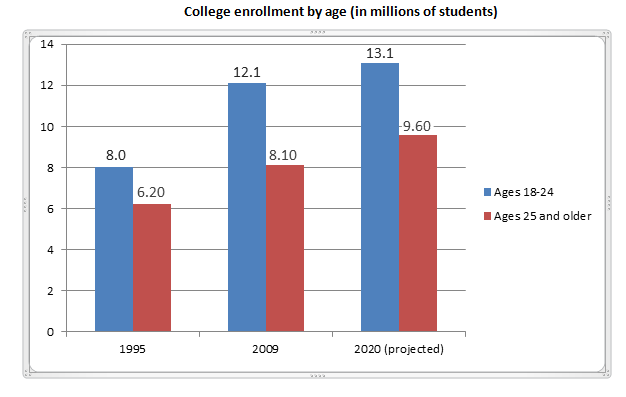enrollment
New government projections forecast dramatic growth in college students 25 and older
The term “college student” still conjures images of freshly-graduated high school seniors arriving on college campuses. However, the reality is that just under 60 percent of college students currently fall in the traditional 18-24 age range, and the proportion of students 25 and older will continue to skew higher as the decade progresses.
The U.S. Department of Education recently released its Projections of Education Statistics to 2020, examining projected changes in educational enrollment from elementary school through college. The report shows a significant increase in the number of students aged 25 and older expected to enroll in college by 2020:

Two factors are driving this trend. First, after a dramatic 32 percent increase in high school graduates between 1996 and 2008, high school graduates are expected to decline nationally by 3 percent between 2008 and 2021.
Second, while enrollment among traditional-aged students is expected to increase by 9 percent between 2009 and 2020, enrollment among students 25-34 may see a 21 percent increase and students 35 and older a 16 percent increase.
What does this mean for campuses? On the recruitment side, campuses may want to expand their recruitment efforts to target adult learners, especially four-year campuses. According to our 2011 Marketing and Student Recruitment Practices Report, only 65 percent of four-year public institutions and 51 percent of four-year private campuses reported targeting adult learners and other nontraditional students; by comparison, 84 percent of community and technical colleges reported targeting these same populations. In terms of retaining older students at traditional campuses (those not primarily serving adult learners), institutions will need to assess and be aware of the different needs of adult students, a topic explored in the Adult Student Priorities Report. As the data show, older students who have jobs and families may have different needs and expectations regarding class scheduling, faculty availability outside of the classroom, academic support services, and the ease of completing tasks such as registering for classes or applying for financial aid.
More importantly, many campuses need to prepare for additional demographic shifts such as the growing diversity of students, a widening gender gap in college enrollment, and increases in the numbers of first-generation college students. Tackling these issues requires long-range, strategic enrollment planning. Based on responses in the 2011 Marketing and Student Recruitment Practices Report, this will not be an easy task. Not only do many campuses report not having any sort of strategic, multi-year enrollment plan, the majority of those that do have plans in place said they did not feel good about their plans. With these changes already under way, colleges and universities will have to move quickly to stay ahead of the trends.
If you have any questions about how to prepare your campus for these demographic changes, please e-mail us.